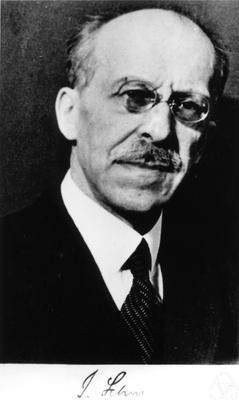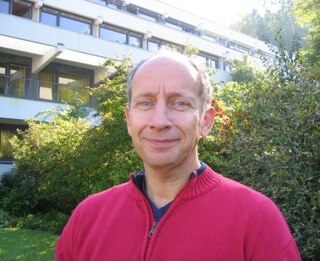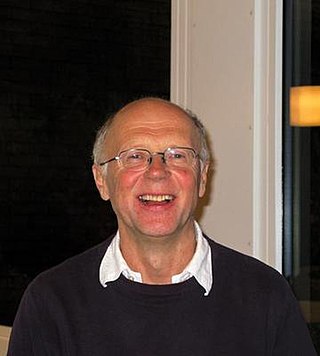Related Research Articles

Felix Hausdorff was a German mathematician, pseudonym Paul Mongré, who is considered to be one of the founders of modern topology and who contributed significantly to set theory, descriptive set theory, measure theory, and functional analysis.

Gerhard Karl Erich Gentzen was a German mathematician and logician. He made major contributions to the foundations of mathematics, proof theory, especially on natural deduction and sequent calculus. He died of starvation in a Czech prison camp in Prague in 1945, having been interned as a German national after the Second World War.

Hermann Günther Grassmann was a German polymath known in his day as a linguist and now also as a mathematician. He was also a physicist, general scholar, and publisher. His mathematical work was little noted until he was in his sixties. His work preceded and exceeded the concept which is now known as a vector space. He introduced the Grassmannian, the space which parameterizes all k-dimensional linear subspaces of an n-dimensional vector space V.

Hermann Klaus Hugo Weyl, was a German mathematician, theoretical physicist, logician and philosopher. Although much of his working life was spent in Zürich, Switzerland, and then Princeton, New Jersey, he is associated with the University of Göttingen tradition of mathematics, represented by Carl Friedrich Gauss, David Hilbert and Hermann Minkowski.
In mathematics, the uniformization theorem states that every simply connected Riemann surface is conformally equivalent to one of three Riemann surfaces: the open unit disk, the complex plane, or the Riemann sphere. The theorem is a generalization of the Riemann mapping theorem from simply connected open subsets of the plane to arbitrary simply connected Riemann surfaces.
Elwin Bruno Christoffel was a German mathematician and physicist. He introduced fundamental concepts of differential geometry, opening the way for the development of tensor calculus, which would later provide the mathematical basis for general relativity.

Issai Schur was a Russian mathematician who worked in Germany for most of his life. He studied at the University of Berlin. He obtained his doctorate in 1901, became lecturer in 1903 and, after a stay at the University of Bonn, professor in 1919.
The study of manifolds combines many important areas of mathematics: it generalizes concepts such as curves and surfaces as well as ideas from linear algebra and topology. Certain special classes of manifolds also have additional algebraic structure; they may behave like groups, for instance. In that case, they are called Lie Groups. Alternatively, they may be described by polynomial equations, in which case they are called algebraic varieties, and if they additionally carry a group structure, they are called algebraic groups.

Andreas Speiser was a Swiss mathematician and philosopher of science.

Wolfgang Lück is a German mathematician who is an internationally recognized expert in algebraic topology.

Paul Finsler was a German and Swiss mathematician.

Matthias Kreck is a German mathematician who works in the areas of Algebraic Topology and Differential topology. From 1994 to 2002 he was director of the Oberwolfach Research Institute for Mathematics and from October 2006 to September 2011 he was the director of the Hausdorff Center for Mathematics at the University of Bonn, where he is currently a professor.

Egbert Valentin Brieskorn was a German mathematician who introduced Brieskorn spheres and the Brieskorn–Grothendieck resolution.

Horst Knörrer is a German mathematician, who studies algebraic geometry and mathematical physics.
Jan Pieter Hogendijk is a Dutch mathematician and historian of science. Since 2005, he is professor of history of mathematics at the University of Utrecht.

Jürgen Jost is a German mathematician specializing in geometry. He has been a director of the Max Planck Institute for Mathematics in the Sciences in Leipzig since 1996.
Mathematics in Nazi Germany was heavily affected by Nazi policies. Though Jews had previously faced discrimination in academic institutions, the Civil Service Law of 1933 led to the dismissal of many Jewish mathematics professors and lecturers at German universities. During this time, many Jewish mathematicians left Germany and took positions at American universities.
Johann Jakob Burckhardt was a Swiss mathematician and crystallographer. He was an invited speaker at the International Congress of Mathematicians in 1936 in Oslo.

Günther Hans Frei is a Swiss mathematician and historian of mathematics.
Walter Purkert is a German mathematician and historian of mathematics.
References
- 1 2 3 "Erhard Scholz, Prof., Dr. rer. nat". Mathematik, Universität Wuppertal.
- ↑ Erhard Scholz at the Mathematics Genealogy Project
- ↑ Scholz, Erhard (1982). "Herbart's influence on Bernhard Riemann". Historia Mathematica. 9 (4): 413–440. doi: 10.1016/0315-0860(82)90106-9 . ISSN 0315-0860.
- ↑ Scholz Schelling und die dynamistische Kristallographie im 19. Jahrhundert, in Selbstorganisation, Jahrbuch für Komplexität in den Natur- Geistes- und Sozialwissenschaften, vol. 5, 1994, 219–230
- ↑ Scholz Symmetrie-Gruppe-Dualität, 1989
- ↑ Scholz, Erhard (2012). "Leibnizian Traces in H. Weyl's Philosophie der Mathematik und Naturwissenschaft". In Krömer, R.; Chin-Drian, Y. (eds.). New Essays on Leibniz Reception. pp. 203–216. doi:10.1007/978-3-0346-0504-5_10. ISBN 978-3-0346-0503-8.
- ↑ Scholz, Erhard (1995). "Hermann Weyl's "Purely Infinitesimal Geometry"". Proceedings of the International Congress of Mathematicians. Basel: Birkhäuser Basel. pp. 1592–1603. doi:10.1007/978-3-0348-9078-6_156. ISBN 978-3-0348-9897-3.
- ↑ Hausdorff Edition